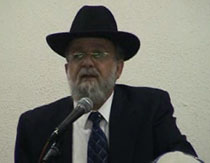Beit Midrash
- Sections
- Chemdat Yamim
- Bemare Habazak - Rabbis Questions
- Jewish Laws and Thoughts
- Prayer
- Shul
Answer: A few gemarot are relevant. One (Berachot 18a) forbids putting a sefer Torah under one’s saddle when riding an animal unless it is necessary to protect it. Another gemara (Menachot 32b) cites an opinion (accepted by the Shulchan Aruch, Yoreh Deah 282:7) that one may not sit on a bed that has a sefer Torah on it. A final gemara (Berachot 24b, see Shulchan Aruch, Orach Chayim 40:3) discusses having tefillin that are incased in coverings under him as one lies in bed. It is a forbidden disgrace if they are under his feet. It is more lenient if they are by his head, especially if not directly below it.

Bemare Habazak - Rabbis Questions (628)
Rabbi Daniel Mann
323 - Moving Kugel into a Cholent Pot
324 - Sefarim under Seats
325 - Davening in Front of a Mirror
Load More
Yet, there is some room for leniency because one does not sit on it but above it. As Bnei Yonah (YD 282:7) points out, it is certainly permitted to walk in a room directly above a sefer Torah on the floor below. In that, there is a clear break between where one is sitting/standing and the holy article. In contrast, not all agree that being directly under the top of "storage box" creates such a separation (Rama, ibid.; Taz, YD 282:4). A very large box, (containing 40 se’ah – approximately the size of a person) makes it considered a separate domain and permitted to sit above (ibid.).
The gemara does mention that the tefillin are beyond disgrace if they are three tefachim (around ten inches) above or below where the person is lying. However, not all agree that so much space is necessary. The Ohalei Yaakov (2) suggests the following based on a comparison to sitting next to a sefer Torah. If the Torah is not directly on the bed but rests on something of even minimal height which is on top of the bed, one may sit elsewhere on the bed. So too, when sitting on the storage box, if there is any noticeable space between the tefillin and the bottom of the seat, it is permitted because of the separation. The Mishna Berura (40:13) cites the stringent and lenient as equals; if there is a tefach of space, he permits it. The Tiferet L’Moshe (YD 282; see Pitchei Teshuva, YD 282:8) says that the matter depends whether the bottom of the cover/seat touches the tefillin [case]. His distinction probably is not about separation but about connection. The gemara talks about soft coverings around the tefillin, so that one’s weight presses on them and thus disgraces them. When they do not touch/press, there is less disgrace. Ohalei Yaakov also suggests that in a crowded shul, the idea of protecting the holy article might apply.
One might argue for more leniency when discussing, not a sefer Torah or tefillin, but printed Torah texts. However, this does not create automatic permission (at least for Ashkenazim – see Yabia Omer IX, YD 22) without strong reason for leniency (see Ohalei Yaakov 1). Some say it is better if non-kodesh objects are also present (Pitchei Teshuva ibid.).
Physical distinctions may be significant. Most of the poskim discuss sitting on the box’s cover. The Taz, who was generally machmir, says that if the furniture is connected to the wall, it is permitted. Presumably, the same is true if the bench is drilled into the floor. If the box is separate from the bench, it is likely not considered that one is sitting on the sefarim below. What you describe as a shelf connected to the bench seems equivalent to what the poskim discuss (see Shemirat Shabbat K’hilchata 20:35 regarding muktzeh in the drawer of a table).
In summary, leniency is certainly legitimate in your case, with it being somewhat better if: you do not have tefillin in there; there is room between the top sefer and the seat above; non-kodesh objects are also present.

Ask the Rabbi: Timing of Ma’aser Kesafim
Rabbi Daniel Mann | Sivan 5785

Ask the Rabbi: Wearing a Kippa in Today’s US Social Atmosphere
Rabbi Daniel Mann | Tammuz 5785

Ask the Rabbi: Transporting Children before or after Shacharit?
Rabbi Daniel Mann | Kislev 5786

Ask the Rabbi: The Transition from Shabbat into Tisha B’av
Rabbi Daniel Mann | Av 5785

Rabbi Daniel Mann

Ribbit in a Loan from an Irrevocable Trust Fund
Adar 7 5777

Bikur Cholim by Electronic Means
Shvat 1 5782

Reciting Borei Nefashot on Food When One Will Still Drink
Sivan 3 5780




















